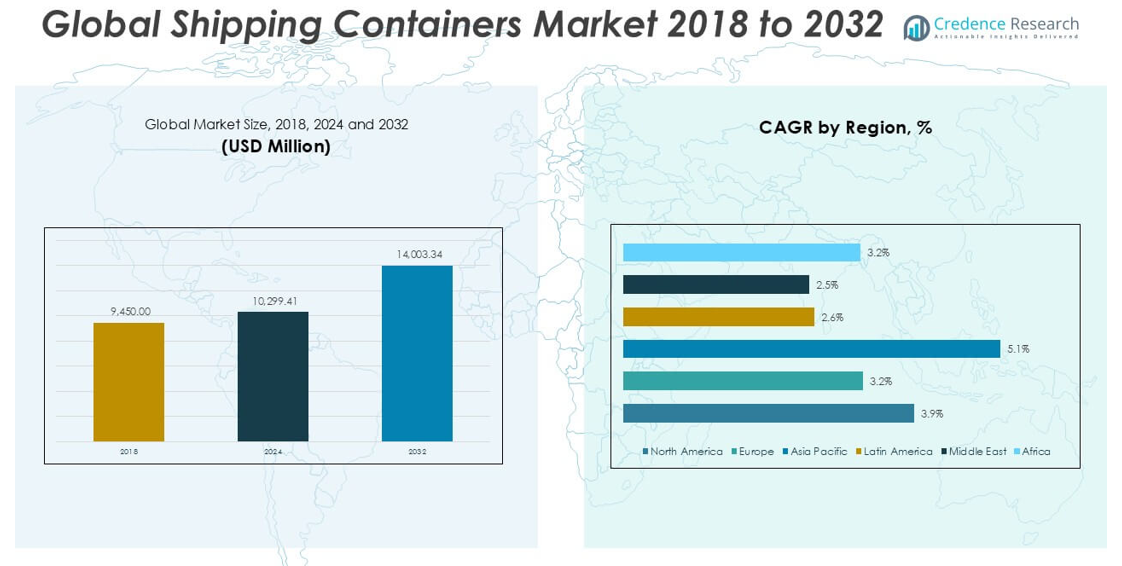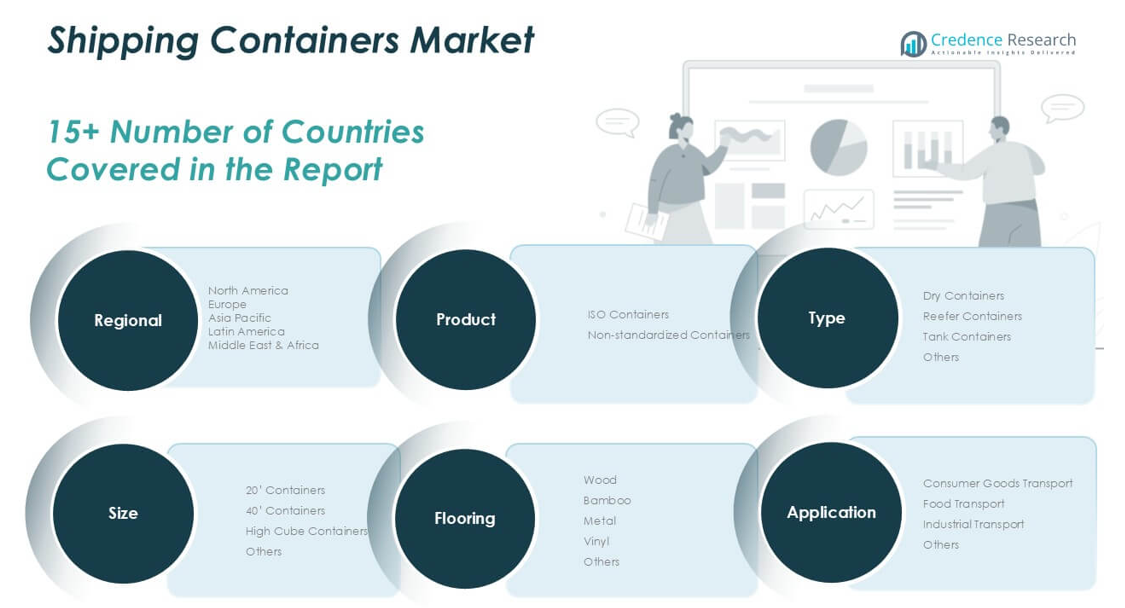CHAPTER NO. 1 : GENESIS OF THE MARKET
1.1 Market Prelude – Introduction & Scope
1.2 The Big Picture – Objectives & Vision
1.3 Strategic Edge – Unique Value Proposition
1.4 Stakeholder Compass – Key Beneficiaries
CHAPTER NO. 2 : EXECUTIVE LENS
2.1 Pulse of the Industry – Market Snapshot
2.2 Growth Arc – Revenue Projections (USD Million)
2.3. Premium Insights – Based on Primary Interviews
CHAPTER NO. 3 : SHIPPING CONTAINERS MARKET FORCES & INDUSTRY PULSE
3.1 Foundations of Change – Market Overview
3.2 Catalysts of Expansion – Key Market Drivers
3.2.1 Momentum Boosters – Growth Triggers
3.2.2 Innovation Fuel – Disruptive Technologies
3.3 Headwinds & Crosswinds – Market Restraints
3.3.1 Regulatory Tides – Compliance Challenges
3.3.2 Economic Frictions – Inflationary Pressures
3.4 Untapped Horizons – Growth Potential & Opportunities
3.5 Strategic Navigation – Industry Frameworks
3.5.1 Market Equilibrium – Porter’s Five Forces
3.5.2 Ecosystem Dynamics – Value Chain Analysis
3.5.3 Macro Forces – PESTEL Breakdown
3.6 Price Trend Analysis
3.6.1 Regional Price Trend
3.6.2 Price Trend by product
CHAPTER NO. 4 : KEY INVESTMENT EPICENTER
4.1 Regional Goldmines – High-Growth Geographies
4.2 Product Frontiers – Lucrative Product Categories
4.3 Application Sweet Spots – Emerging Demand Segments
CHAPTER NO. 5: REVENUE TRAJECTORY & WEALTH MAPPING
5.1 Momentum Metrics – Forecast & Growth Curves
5.2 Regional Revenue Footprint – Market Share Insights
5.3 Segmental Wealth Flow – Type & Application Revenue
CHAPTER NO. 6 : TRADE & COMMERCE ANALYSIS
6.1. Import Analysis by Region
6.1.1. Global Shipping Containers Market Import Revenue By Region
6.2. Export Analysis by Region
6.2.1. Global Shipping Containers Market Export Revenue By Region
CHAPTER NO. 7 : COMPETITION ANALYSIS
7.1. Company Market Share Analysis
7.1.1. Global Shipping Containers Market: Company Market Share
7.2. Global Shipping Containers Market Company Revenue Market Share
7.3. Strategic Developments
7.3.1. Acquisitions & Mergers
7.3.2. New Product Launch
7.3.3. Regional Expansion
7.4. Competitive Dashboard
7.5. Company Assessment Metrics, 2024
CHAPTER NO. 8 : SHIPPING CONTAINERS MARKET – BY TYPE SEGMENT ANALYSIS
8.1. Shipping Containers Market Overview by Type Segment
8.1.1. Shipping Containers Market Revenue Share By Type
8.2. Dry Containers
8.3. Reefer Containers
8.4. Tank Containers
8.5. Others
CHAPTER NO. 9 : SHIPPING CONTAINERS MARKET – BY APPLICATION SEGMENT ANALYSIS
9.1. Shipping Containers Market Overview by Application Segment
9.1.1. Shipping Containers Market Revenue Share By Application
9.2. Consumer Goods Transport
9.3. Food Transport
9.4. Industrial Transport
9.5. Others
CHAPTER NO. 10 : SHIPPING CONTAINERS MARKET – BY PRODUCT SEGMENT ANALYSIS
10.1. Shipping Containers Market Overview by Product Segment
10.1.1. Shipping Containers Market Revenue Share By Product
10.2. ISO Containers
10.3. Non-standardized Containers
CHAPTER NO. 11 : SHIPPING CONTAINERS MARKET – BY SIZE SEGMENT ANALYSIS
11.1. Shipping Containers Market Overview by Size Segment
11.1.1. Shipping Containers Market Revenue Share By Size
11.2. 20’ Containers
11.3. 40’ Containers
11.4. High Cube Containers
11.5. Others
CHAPTER NO. 12 : SHIPPING CONTAINERS MARKET – BY FLOORING SEGMENT ANALYSIS
12.1. Shipping Containers Market Overview by Flooring Segment
12.1.1. Shipping Containers Market Revenue Share By Flooring
12.2. Wood
12.3. Bamboo
12.4. Metal
12.5. Vinyl
12.6. Others
CHAPTER NO. 13 : SHIPPING CONTAINERS MARKET – REGIONAL ANALYSIS
13.1. Shipping Containers Market Overview by Region Segment
13.1.1. Global Shipping Containers Market Revenue Share By Region
13.1.2. Regions
13.1.3. Global Shipping Containers Market Revenue By Region
13.1.4. Type
13.1.5. Global Shipping Containers Market Revenue By Type
13.1.6. Application
13.1.7. Global Shipping Containers Market Revenue By Application
13.1.8. Product
13.1.9. Global Shipping Containers Market Revenue By Product
13.1.10. Size
13.1.12. Global Shipping Containers Market Revenue By Size
13.1.13. Flooring
13.1.14. Global Shipping Containers Market Revenue By Flooring
CHAPTER NO. 14 : NORTH AMERICA SHIPPING CONTAINERS MARKET – COUNTRY ANALYSIS
14.1. North America Shipping Containers Market Overview by Country Segment
14.1.1. North America Shipping Containers Market Revenue Share By Region
14.2. North America
14.2.1. North America Shipping Containers Market Revenue By Country
14.2.2. Type
14.2.3. North America Shipping Containers Market Revenue By Type
14.2.4. Application
14.2.5. North America Shipping Containers Market Revenue By Application
14.2.6. Product
14.2.7. North America Shipping Containers Market Revenue By Product
14.2.8. Size
14.2.9. North America Shipping Containers Market Revenue By Size
14.2.10. Flooring
14.2.11. North America Shipping Containers Market Revenue By Flooring
14.3. U.S.
14.4. Canada
14.5. Mexico
CHAPTER NO. 15 : EUROPE SHIPPING CONTAINERS MARKET – COUNTRY ANALYSIS
15.1. Europe Shipping Containers Market Overview by Country Segment
15.1.1. Europe Shipping Containers Market Revenue Share By Region
15.2. Europe
15.2.1. Europe Shipping Containers Market Revenue By Country
15.2.2. Type
15.2.3. Europe Shipping Containers Market Revenue By Type
15.2.4. Application
15.2.5. Europe Shipping Containers Market Revenue By Application
15.2.6. Product
15.2.7. Europe Shipping Containers Market Revenue By Product
15.2.8. Size
15.2.9. Europe Shipping Containers Market Revenue By Size
15.2.10. Flooring
15.2.11. Europe Shipping Containers Market Revenue By Flooring
15.3. UK
15.4. France
15.5. Germany
15.6. Italy
15.7. Spain
15.8. Russia
15.9. Rest of Europe
CHAPTER NO. 16 : ASIA PACIFIC SHIPPING CONTAINERS MARKET – COUNTRY ANALYSIS
16.1. Asia Pacific Shipping Containers Market Overview by Country Segment
16.1.1. Asia Pacific Shipping Containers Market Revenue Share By Region
16.2. Asia Pacific
16.2.1. Asia Pacific Shipping Containers Market Revenue By Country
16.2.2. Type
16.2.3. Asia Pacific Shipping Containers Market Revenue By Type
16.2.4. Application
16.2.5. Asia Pacific Shipping Containers Market Revenue By Application
16.2.6. Product
16.2.7. Asia Pacific Shipping Containers Market Revenue By Product
16.2.8. Size
16.2.9. Asia Pacific Shipping Containers Market Revenue By Size
16.2.10. Flooring
16.2.11. Asia Pacific Shipping Containers Market Revenue By Flooring
16.3. China
16.4. Japan
16.5. South Korea
16.6. India
16.7. Australia
16.8. Southeast Asia
16.9. Rest of Asia Pacific
CHAPTER NO. 17 : LATIN AMERICA SHIPPING CONTAINERS MARKET – COUNTRY ANALYSIS
17.1. Latin America Shipping Containers Market Overview by Country Segment
17.1.1. Latin America Shipping Containers Market Revenue Share By Region
17.2. Latin America
17.2.1. Latin America Shipping Containers Market Revenue By Country
17.2.2. Type
17.2.3. Latin America Shipping Containers Market Revenue By Type
17.2.4. Application
17.2.5. Latin America Shipping Containers Market Revenue By Application
17.2.6. Product
17.2.7. Latin America Shipping Containers Market Revenue By Product
17.2.8. Size
17.2.9. Latin America Shipping Containers Market Revenue By Size
17.2.10. Flooring
17.2.11. Latin America Shipping Containers Market Revenue By Flooring
17.3. Brazil
17.4. Argentina
17.5. Rest of Latin America
CHAPTER NO. 18 : MIDDLE EAST SHIPPING CONTAINERS MARKET – COUNTRY ANALYSIS
18.1. Middle East Shipping Containers Market Overview by Country Segment
18.1.1. Middle East Shipping Containers Market Revenue Share By Region
18.2. Middle East
18.2.1. Middle East Shipping Containers Market Revenue By Country
18.2.2. Type
18.2.3. Middle East Shipping Containers Market Revenue By Type
18.2.4. Application
18.2.5. Middle East Shipping Containers Market Revenue By Application
18.2.6. Product
18.2.7. Middle East Shipping Containers Market Revenue By Product
18.2.8. Size
18.2.9. Middle East Shipping Containers Market Revenue By Size
18.2.10. Flooring
18.2.11. Middle East Shipping Containers Market Revenue By Flooring
18.3. GCC Countries
18.4. Israel
18.5. Turkey
18.6. Rest of Middle East
CHAPTER NO. 19 : AFRICA SHIPPING CONTAINERS MARKET – COUNTRY ANALYSIS
19.1. Africa Shipping Containers Market Overview by Country Segment
19.1.1. Africa Shipping Containers Market Revenue Share By Region
19.2. Africa
19.2.1. Africa Shipping Containers Market Revenue By Country
19.2.2. Type
19.2.3. Africa Shipping Containers Market Revenue By Type
19.2.4. Application
19.2.5. Africa Shipping Containers Market Revenue By Application
19.2.6. Product
19.2.7. Africa Shipping Containers Market Revenue By Product
19.2.8. Size
19.2.9. Africa Shipping Containers Market Revenue By Size
19.2.10. Flooring
19.2.11. Africa Shipping Containers Market Revenue By Flooring
19.3. South Africa
19.4. Egypt
19.5. Rest of Africa
CHAPTER NO. 20 : COMPANY PROFILES
20.1. A.P. Moller – Maersk
20.1.1. Company Overview
20.1.2. Product Portfolio
20.1.3. Financial Overview
20.1.4. Recent Developments
20.1.5. Growth Strategy
20.1.6. SWOT Analysis
20.2. Bertschi AG
20.3. BNH Gas Tanks
20.4. Bulkhaul Limited
20.5. Danteco Industries BV
20.6. NewPort Tank
20.7. China International Marine Containers (Group) Ltd
20.8. COSCO SHIPPING Development Co., Ltd.
20.9. CXIC Group
20.10. IWES LTD.
20.11. Norcomp Nordic AB
20.12. Singamas Container Holdings Limited
20.13. TLS Offshore Containers/TLS Special Containers
20.14. W&K Containers, Inc.
20.15. Thurston Group Limited
20.16. OEG
20.17. Sea Box, Inc.









